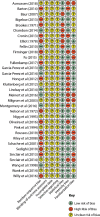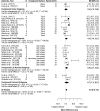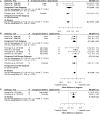Is Motorized Treadmill Running Biomechanically Comparable to Overground Running? A Systematic Review and Meta-Analysis of Cross-Over Studies
- PMID: 31802395
- PMCID: PMC7069922
- DOI: 10.1007/s40279-019-01237-z
Is Motorized Treadmill Running Biomechanically Comparable to Overground Running? A Systematic Review and Meta-Analysis of Cross-Over Studies
Abstract
Background: Treadmills are often used in research, clinical practice, and training. Biomechanical investigations comparing treadmill and overground running report inconsistent findings.
Objective: This study aimed at comparing biomechanical outcomes between motorized treadmill and overground running.
Methods: Four databases were searched until June 2019. Crossover design studies comparing lower limb biomechanics during non-inclined, non-cushioned, quasi-constant-velocity motorized treadmill running with overground running in healthy humans (18-65 years) and written in English were included. Meta-analyses and meta-regressions were performed where possible.
Results: 33 studies (n = 494 participants) were included. Most outcomes did not differ between running conditions. However, during treadmill running, sagittal foot-ground angle at footstrike (mean difference (MD) - 9.8° [95% confidence interval: - 13.1 to - 6.6]; low GRADE evidence), knee flexion range of motion from footstrike to peak during stance (MD 6.3° [4.5 to 8.2]; low), vertical displacement center of mass/pelvis (MD - 1.5 cm [- 2.7 to - 0.8]; low), and peak propulsive force (MD - 0.04 body weights [- 0.06 to - 0.02]; very low) were lower, while contact time (MD 5.0 ms [0.5 to 9.5]; low), knee flexion at footstrike (MD - 2.3° [- 3.6 to - 1.1]; low), and ankle sagittal plane internal joint moment (MD - 0.4 Nm/kg [- 0.7 to - 0.2]; low) were longer/higher, when pooled across overground surfaces. Conflicting findings were reported for amplitude of muscle activity.
Conclusions: Spatiotemporal, kinematic, kinetic, muscle activity, and muscle-tendon outcome measures are largely comparable between motorized treadmill and overground running. Considerations should, however, particularly be given to sagittal plane kinematic differences at footstrike when extrapolating treadmill running biomechanics to overground running. Protocol registration CRD42018083906 (PROSPERO International Prospective Register of Systematic Reviews).
Conflict of interest statement
Joel T. Fuller and Jonathan D. Buckley have been authors on some research projects that have evaluated the effects of different running shoes on running performance, biomechanics and physiology; those projects involved the use of running shoes that were donated by the shoe industry, either from running shoe retail stores or ASICS Oceania. Chris Bishop has received funding from both ASICS Oceania and Brittain Wynyard for professional services related to footwear. Guillaume Rao has received funding from Decathlon for professional services related to footwear to evaluate the effects of different running shoes on running performance, biomechanics and physiology. No companies played any role in the design, conduct or interpretation of the present research. The remaining authors declare no conflicts of interest.
Figures







Comment in
-
Authors' Reply to Dewolf et al.: "Is Motorized Treadmill Running Biomechanically Comparable to Overground Running? A Systematic Review and Meta-Analysis of Cross-Over Studies".Sports Med. 2020 Sep;50(9):1699. doi: 10.1007/s40279-020-01305-9. Sports Med. 2020. PMID: 32524455 No abstract available.
-
Comment on: "Is Motorized Treadmill Running Biomechanically Comparable to Overground Running? A Systematic Review and Meta-Analysis of Cross-Over Studies".Sports Med. 2020 Sep;50(9):1695-1698. doi: 10.1007/s40279-020-01304-w. Sports Med. 2020. PMID: 32524456 No abstract available.
References
-
- Running USA. 2017 National Runner Survey. 2017. https://www.runningusa.org/RUSA/Research/Recent_Surveys/National_Runner_....
-
- Tjelta LI. A longitudinal case study of the training of the 2012 European 1500 m track champion. Int J Appl Sports Sci. 2013;25:11–18. doi: 10.24985/ijass.2013.25.1.11. - DOI
-
- Dingenen B, Malliaras P, Janssen T, Ceyssens L, Vanelderen R, Barton CJ. Two-dimensional video analysis can discriminate differences in running kinematics between recreational runners with and without running-related knee injury. Phys Ther Sport. 2019;38:184–191. doi: 10.1016/j.ptsp.2019.05.008. - DOI - PubMed
Publication types
MeSH terms
LinkOut - more resources
Full Text Sources
Medical

